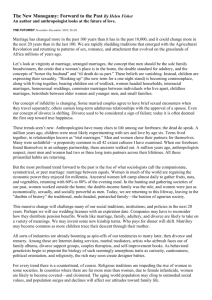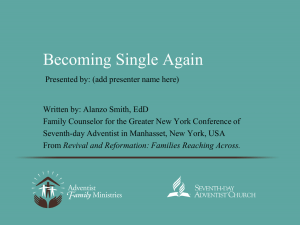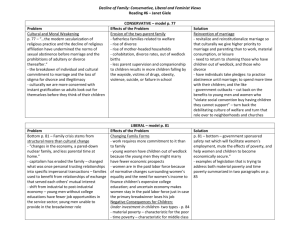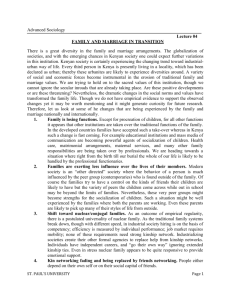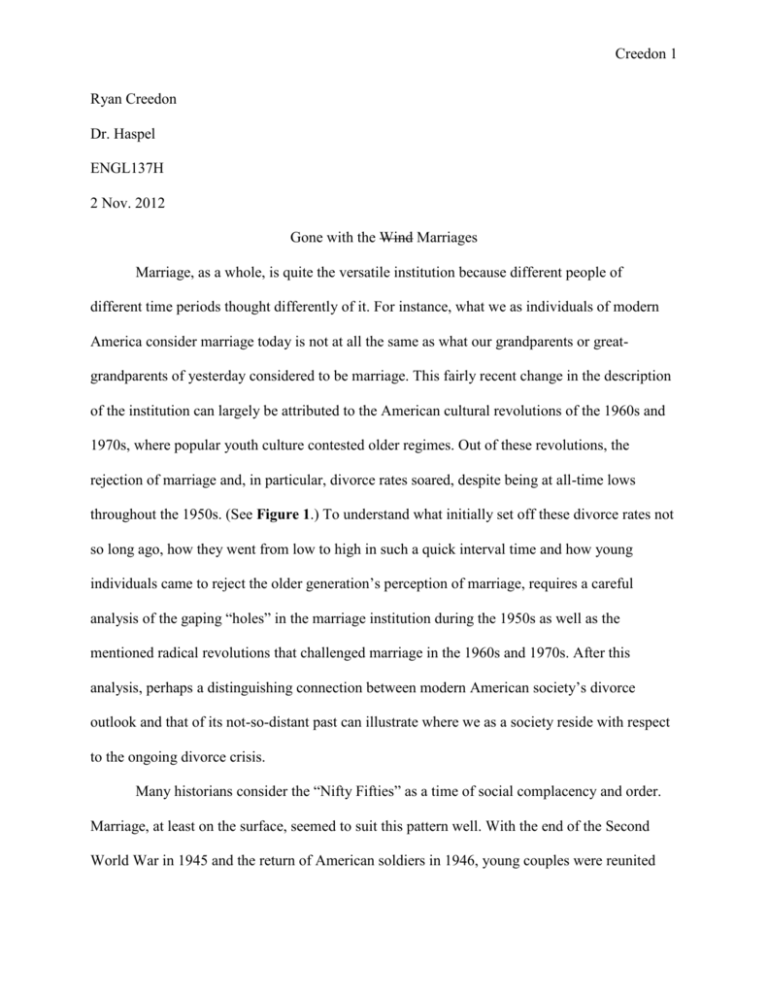
Creedon 1
Ryan Creedon
Dr. Haspel
ENGL137H
2 Nov. 2012
Gone with the Wind Marriages
Marriage, as a whole, is quite the versatile institution because different people of
different time periods thought differently of it. For instance, what we as individuals of modern
America consider marriage today is not at all the same as what our grandparents or greatgrandparents of yesterday considered to be marriage. This fairly recent change in the description
of the institution can largely be attributed to the American cultural revolutions of the 1960s and
1970s, where popular youth culture contested older regimes. Out of these revolutions, the
rejection of marriage and, in particular, divorce rates soared, despite being at all-time lows
throughout the 1950s. (See Figure 1.) To understand what initially set off these divorce rates not
so long ago, how they went from low to high in such a quick interval time and how young
individuals came to reject the older generation’s perception of marriage, requires a careful
analysis of the gaping “holes” in the marriage institution during the 1950s as well as the
mentioned radical revolutions that challenged marriage in the 1960s and 1970s. After this
analysis, perhaps a distinguishing connection between modern American society’s divorce
outlook and that of its not-so-distant past can illustrate where we as a society reside with respect
to the ongoing divorce crisis.
Many historians consider the “Nifty Fifties” as a time of social complacency and order.
Marriage, at least on the surface, seemed to suit this pattern well. With the end of the Second
World War in 1945 and the return of American soldiers in 1946, young couples were reunited
Creedon 2
and, after wartime traumas, “[found] solace in the ideas of marriage and parenthood” (Wilcox,
Bradford W.). It was these couples that took inspiration from the 1947 marriage of Queen
Elizabeth II and Prince Philip, Duke of Edinburgh. Upon viewing the picture of this iconic
wedding provided in Figure 2, one can clearly see from Queen Elizabeth II’s posture and decor
two social values that inspired the proceeding ‘50s generation—traditionalism and purity. From
the traditionalist belief, a return to the ceremonial perspective of marriage emerged. (That is to
say that “‘til death do us part” carried more weight in the ‘50s than it did in previous decades.)
Alongside the return of marriage as a spiritual sacrament, purity, or the virgin bride, became
another commonplace, making pre-marital sex a huge social stigma of the time.
After being wedded, couples were expected to make families, and herein, a new
patriarchal family structure emerged. Specifically speaking, it became the social norm for society
to expect a father to provide financially for his children and wife. Likewise, it became the social
norm for society to expect a mother to provide domestic comfort and support for her children and
husband. The net result of these expectations established the familiar nuclear family we as
modern Americans see today. The difference, however, from then and now lies in the strength of
the family unit, which appears much stronger in the ‘50s as a consequence of high social
expectations. All in all, the ‘50s “seemed to be a perfect model of the utopian social order,
wherein the age limit for marriage and motherhood decreased, birthrate increased, marriages
became more long-lived with the decline in the number of divorces, and the new trend of nuclear
families began” (Wilcox, Bradford W.). Yet problems in this seemingly infallible system were
quick to emerge later in the decade.
The conditions under which couples could plead for divorce became the largest source of
these complications because each state had its own divorce policies. Where Washington was
Creedon 3
fairly liberal and allowed couples to choose from a huge selection of causes for divorce—cruelty,
happiness, or disregard of marital obligations among others, South Carolina failed to grant
divorce at all (McNickle, R.K.). Other states had a mixture of property, temporal (measurement
of how long couples had been married), and religious requirements whereby both spouses could
only plead for divorce on the grounds of adultery. For couples who relocated during their
marriage, the situation grew even grimmer, for no lawyers knew by which state policy to suggest
their clients to abide. Therefore, in short, the entire state of divorce was a field day, carrying with
it a large assortment of opinions. Because of these inherent discrepancies in divorce policy, many
men and women unsurprisingly pressured the government for its reform. Even Supreme Court
Justice Jackson declared, “The uncertainties that result [from a disjointed divorce platform] are
not merely technical, nor are they trivial….[T]hey affect fundamental rights and relations” (qtd.
in McNickle, R.K.). The sore wounds of divorce policy would eventually open during the times
of the cultural revolutions in the coming years, but the process would not be complete without
help from a few other “fifties faults.”
From the patriarchal system of the family unit described earlier, complications were
quick to arise, contributing to increased familial problems. Women, who were seen as economic
assets during times of the Great Depression and World War II, returned to the standard American
“cult of domesticity.” This rising social order often restricted a married woman to the confines
of her husband’s house, subjecting her to a lengthy list of ridiculous requirements. Some of these
requirements can be summarized by the following excerpt from a 1950’s home economics
textbook:
“Minimize the noise: At the time of his arrival, eliminate all noise of washer, dryer,
dishwasher, or vacuum. Try to encourage the children to be quiet. Be happy to see him.
Greet him with a warm smile and be glad to see him.
Creedon 4
Some ‘DO NOT’S’: Don't greet him with problems or complaints. Don't complain if he's
late for dinner. Count this as minor compared with what he might have gone through that
day.
Make the evening his: Never complain if he does not take you out to dinner or to other
places of entertainment; instead try to understand his world of strain and pressure and his
need to be home and relax.” (“The Good Housewife”)
In a larger sense, however, this domestic zeitgeist affected just as many single women as it did
married women, for single women had now lost their edge in the economic market. Therefore, to
cope with difficult financial times, these young women often initiated economic marriages. The
failure of these economic marriages and the emphasis on the “good housewife” described above
were imprinted in the minds of the baby boomer generation, thus beginning the massive
revolutions of the 1960s and 1970s against marriage alongside the changing divorce policies.
At first, this attack on marriage began gradually, like a trickle from a faucet. States first
established half-hearted family courts to offer marriage counseling and intervention in intramarital confrontations. Under pressure from struggling couples who needed a divorce, however,
some states began to adopt the covenant marriage policy in the early 1960s. (It has been used
around the United States ever since.) Covenant marriage was a simple ideology: Couples
recognized the sacrifices involved in marriage before getting married and agreed that divorce
should only be used conditionally. Now, throughout the 1960s, the conditions required for
divorce became more and more liberalized. Eventually, a man, then California governor, by the
name of Ronald Reagan “made what he later admitted was one of the biggest mistakes of his
political life” (Wilcox, Bradford W.), signing the first no-fault divorce policy in 1969. Failing
marriages now flooded through the gates of no-fault divorce, and soon, the entire country, under
the leadership of California, was drowning in no-fault divorce laws. It is imperative to note,
however, that no-fault divorce was not the social reason for believing in divorce; it merely made
Creedon 5
divorce easier to obtain. The crumbling ‘50s regime as described previously and the officious
‘60s and ‘70s beliefs discussed next really enhanced no-fault divorce.
In a late 1959 BBC interview titled “Mosaic of Youth,” one young woman stated, “I think
this is stupid all this virginity until you are married business. I think this is terribly Victorian.”
Though of British origins, the same sentiments applied to youth in developed nations
everywhere, including America. This vigor eventually rose against the traditional and pure
marriages of the 1950s in a sexual revolution that spanned subsequent decades. Paramount to this
revolution was the idea of “free love”: People should love others without the social and
economic constraints of marriage and should not fear the social derogations associated with premarital sex. In tandem with this ideology came new scientific discoveries of “fool-proof”
contraceptives that further challenged the conservative ‘50s regime. Many states attempted to
extirpate these contraceptives to preserve pure marriages, to end free love. Despite states’ best
efforts to retain the pure marital institution, the landmark Supreme Court case Griswold v.
Connecticut in 1965, which emphasized the right of a sexual privacy among couples, spoke on
behalf of the new generation, putting to rest the old regime. As a result, many unhappy
individuals of the 1950s who were chained to economic marriages and social criticisms used the
sexual revolution as a means of escape, and some of them went so far as to practice “swinging
partners” with a family friend for sexual experimentation. So, in retrospect, the ‘60s and ‘70s
became a time to find respective “soul mates” as opposed to “business partners,” putting
marriage among more of the least common social “transactions.” Divorce, needless to say, was
taking the nation by storm.
Accompanying the sexual revolution was a new psychology of social order that became
known as anti-institutionalism or, more informally, the “stick-it-to-the-man” attitude. One can
Creedon 6
interpret this new social ideal as a reaction to the conservative ‘50s generation: Where the 1950’s
society shaped the individual, the 1960’s and 1970’s encouraged the individual to shape the
society. Perhaps, the best example of this shift in beliefs was illustrated by fights for gender
equality. As described earlier, ‘50’s marriage coerced women to undertake the four “c’s” in the
household—care, clean, comfort, and cook. Outside these basic domestic chores became male
territory. Throughout the ‘60s and ‘70s, the National Organization for Women saw this marital
structure as an act of women suppression, claiming that it inhibited a woman’s right to
individualism. The end result of the organization’s efforts bestowed women with increasing
authority in marriage but, more importantly, prompted individualism among female
communities. Therefore, rather than committing to marital sacrifices early in their lives, women
began to embrace anti-institutionalism. From the same BBC radio special “Mosaic of Youth,”
another young woman testified, “I want to get around. I want to get married feeling that I’ve
done everything I ever wanted to do.” These beliefs often withheld or ended marriages, adding
more fuel to the divorce fire.
Now, after looking at the evidence for this paradigm shift from a little divorce to a lot of
divorce, one may still argue that all of these events occurred in the past, that we as a society have
“moved on” from the marriage exodus. Chronologically speaking, he or she would be correct.
The radical ideas of the ‘60s and ‘70s have long since dissolved, and the ‘50s now appear to be a
distant illusion of what was the “last age of innocence” (Wilcox, Bradford W.). At the end of the
day, however, America is still among the top fifteen nations for largest divorce rates in the world
today (“Worldwide Divorce Statistics”). We as a society, therefore, still have divorce, and the
ways in which we engage in it have not changed significantly between now and forty years ago.
We still have no-fault divorce. We have had several sexual revolutions between the ‘70s and
Creedon 7
today that have contributed to the divorce rate more and more each year. We face the potential
for technology to impact our sense of individualism and, therefore, our perception of the marital
institution. And, we even have a reality show on television suggesting that the end to a seventytwo day marriage can be justified under “irreconcilable differences.” Thus, with all these divorce
complications that we as a society face today, should there be any reason why the divorce rates
have not continued their trends from the 1970s to make us number one in the global divorce
department? Well, actually, there is: One factor in the equation that has changed from then and
now is the new emphasis placed on divorce’s impacts on children. Picture books such as
Dinosaurs Divorce or movies such as Mrs. Doubtfire have made profound cultural impacts on
how we view divorce psychologically. In summary, we have reached the conclusion that kids
should not be exposed to the traumas surrounding divorce, especially the notions of “divorce is
final” and “most parents don’t get back together” (M. Brown and L. Brown 10). Therefore, we as
a society have often used children as a way to remedy the divorce explosion of yesteryears. But
the truth is we can never fully conceal what has happened in the time before us. We can never
return to the 1950s. We can never have a complacent family order. Too many radical ideas have
paralyzed the marriage institution, and even using our children as a means to convince others to
believe in the complacent family order will not entirely undo what we have done. In effect, we
will never have the marriage our grandparents or great-grandparents once had. We have our own
way to define marriage today in the aftermath of these divorce rates, namely “divorce is final”
and “gone with the marriages.”
Creedon 8
Attachments
Figure 1: Divorce rates by number of divorces per thousand marriages from 1950 to 2000
(Vanneman)
Figure 2: Picture of Queen Elizabeth II and Prince Philip, Duke of Edinburgh, on their wedding
day (Press Association)
Creedon 9
Works Cited
Brown, Marc and Laurene Krasny Brown. Dinosaurs Divorce. New York: The Atlantic Monthly
Press, 1986. Print.
McNickle, R.K. "Marriage and Divorce." Editorial Research Reports 1949. Vol. I. Washington:
CQ Press, 1949. 81-99. CQ Researcher. Web. 21 Oct. 2012.
“Mosaic of Youth.” Home Service. BBC. 30 Dec. 1959. Radio.
Press Association. Springtime for Britain and Royalty?. Library of Congress.
NationalGeographic.com. Web. 22 Oct. 2012.
“The Good Housewife.” Colorado.edu. Web. 25 Oct. 2012.
Vanneman, Reeve. “Divorce rate trends.” bsos.umd.edu. 8 Oct. 1999. Web. 24 Oct. 2012.
Wilcox, Bradford W. “The Evolution of Divorce.” NationalAffairs.com. 2009. Web. 24 Oct.
2012.
“Worldwide Divorce Statistics.” Divorce.com. 2012. Web. 27 Oct. 2012.




